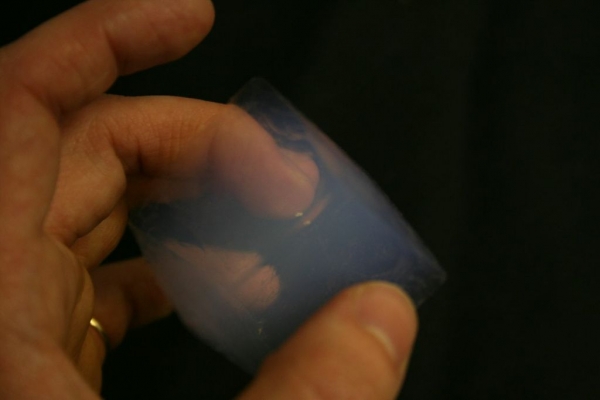
Aerogels are a class of extremely porous solid materials that exhibit an array of unusual properties including extremely low density, high surface area, high electrical conductivity and highly insulating properties. The lowest density solid materials that have ever been produced have all been aerogels, including a silica aerogel that was only 3 times heavier than air, and less dense when the air in its pores was sucked out.
Aerogels can be made from a range of different materials including carbon, metal oxides and gelatin, but the term aerogel is often used to refer to the eerily blue silica aerogel that we have in our collection. This aerogel is manufactured by creating a silica-based gel, and then evaporating the liquid component without destroying the solid framework of the gel, to leave behind an extremely delicate glass-like structure filled with nano-scale air bubbles.
This is done through a process known as supercritical drying. If you were to just dry the gel ordinarily (e.g. through evaporation) the solid framework of the gel would collapse and it would shrink as liquid evaporates from the surface and moves through the structure by capillary action. The supercritical drying process takes advantage of the ‘critical point’ of supercritical fluids like methanol and carbon dioxide. The critical point is the temperature and pressure at which the distinction between a liquid and a gas disappears so that it no longer exerts capillary forces and it can be removed without destroying the filigree network of the silica gel. This process is a bit like sucking the water out of a kitchen sponge to leave the foam behind, but the resulting solid is not elastic but very brittle, as these fragments demonstrate.
Silica aerogel is 99.9% air, and this is what gives it the almost eerie appearance that has earned it the nickname of ‘solid smoke’. The material appears to be less visible than a chunk of glass despite being more opaque because there is no hint of reflection on its surface, giving it the appearance of not being fully solid. Its azure colour is not due to any pigmentation, but is caused by the same phenomenon that gives colour to the Earth's atmosphere, namely Raleigh scattering of light. In other words, it is blue for the same reasons that the sky is blue.
Aerogels were first produced in the 1920s or 30s and its earliest uses were in the 1950s as a thickening agent for paint, napalm and sheep medications, and as a filter in cigarettes.
This sample was made by Steve M. Jones, NASA Jet Propulsion Laboratory as part of the Stardust research project, which involved sending a spacecraft containing a large piece of aerogel on a close approach to the comet Wild 2 in order to collect space-dust. What made aerogel ideal for the mission was that this ultra-fine foam can gradually decelerate and capture dust particles in pristine condition. The process of then sifting through the aerogel, micron by micron, to identify and collect the space-dust was the world’s largest collaborative microscopy activity.
Sample ID: 264
Particularities
- Maker
- NASA Jet Propulsion Lab
- Selections
- Superlative Materials
- Categories
- Glass
- Curiosities
- Damaged
- Relationships
- Accidental | Blue | Brittle | Foam | Fragile | Insulating | Insulation | Levitation | Light Weight | Low Density | NASA | Porous | Silica | Supercritical Drying | Surface Area
Add materials you find interesting to your own selections.
Use the  button to select a material and get started.
button to select a material and get started.

